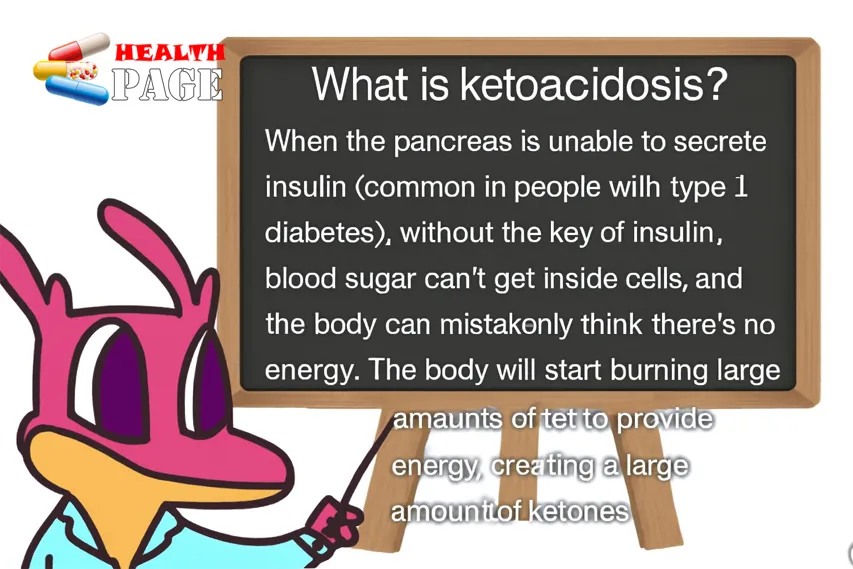What is alcoholic ketoacidosis? What precautions should be taken when drinking alcohol?
If you want to try the ketogenic diet , someone around you will immediately tell you that you can’t eat rice, noodles, or sugar, and that breaking down fat will lead to too many ketones that you can’t metabolize completely, which will cause ketoacidosis and even death!
In fact, as long as you are a normal person, as long as you still have insulin secretion for energy, and you do not have type 1 diabetes or late-stage type 2 diabetes, you will not experience ketoacidosis.

However, not all patients with type 1 diabetes will develop ketoacidosis. Research by Harvard University professor Dr. David Ludwig found that approximately 2% of type 1 diabetes patients are at risk of developing ketoacidosis . Related reading → Groundbreaking research, rewriting history, may diabetes be completely reversed?
In short, for most people, you will be in a state of nutritional ketosis , so there is no need to worry.
However, people who frequently drink alcohol need to be careful, because even if you don’t follow a low-carb ketogenic diet, you may still develop alcoholic ketoacidosis from frequent drinking.
Why does drinking alcohol cause ketoacidosis? How is it diagnosed and treated? If you enjoy drinking, pay attention to these symptoms!
What is alcoholic ketoacidosis?
Generally speaking, the most common cause of alcoholic ketoacidosis is excessive ethanol , loss of appetite (hunger), and repeated vomiting (fluid imbalance).

Most people with a strong alcohol addiction would rather go without food than without alcohol, unconsciously reducing their intake of other dietary sources. As a result, their bodies are in a state of chronic glycogen and protein deficiency, nutritional deficiencies, and general malaise .
Furthermore, excessive drinking can lead to repeated vomiting , resulting in dehydration; loss of appetite depletes the body’s protein and glycogen stores.

In addition, alcohol itself is toxic . I wrote an article before: The Lancet: Don’t drink a drop of alcohol , based on the latest research in The Lancet.
Moderate alcohol consumption offers no health benefits, let alone excessive consumption. Excessive ethanol intake can cause gastritis, pancreatitis, and liver damage , all of which can potentially lead to pathological ketoacidosis.
→ Pathological mechanism of alcoholic ketoacidosis
Alcoholic ketoacidosis was first proposed by Edward S. Dillon and several of his colleagues in the United States in 1940. About 10% of alcohol poisoning patients present with alcoholic ketoacidosis , which is more common in people with liver disease and severe alcoholism, and is one of the leading causes of death among alcoholics.
We’ve just gained a general understanding of the causes of alcoholic ketoacidosis, but the process is actually quite complex. The body undergoes a series of changes that ultimately lead to alcoholic ketoacidosis, including:
1. Relatively reduced insulin secretion, or excessive glucagon secretion;
This is usually caused by factors such as inhibited gluconeogenesis , lack of liver glycogen, and stimulation of alpha-adrenaline secretion after vomiting, which leads to decreased insulin levels and increased glucagon levels , promoting fat breakdown. At the same time, alcohol is directly converted into ketone bodies in the liver, causing ketone body accumulation.
Furthermore, after drinking alcohol, the liver inhibits the release of glycogen, leading to hypoglycemia , and begins to break down fat, causing ketone bodies to rise.
2. The increase in the NADH/NAD ratio;
Ethanol is oxidized to acetaldehyde and acetic acid in liver cells, which reduces coenzyme I (NAD) to NADH ( reduced coenzyme I), thereby generating a large amount of NADH, disrupting the NADH/NAD balance, increasing the intracellular oxidation ratio, causing metabolic abnormalities, ketone body accumulation, and leading to ketoacidosis.
3. Extreme extracellular fluid deficiency;
This is caused by vomiting or insufficient water intake, which can activate the sympathetic nervous system , increasing the secretion of certain hormones, such as adrenaline , cortisol, and glucagon, further stimulating the formation of free fatty acids and ketone bodies.
Severe dehydration can even lead to a sharp drop in blood volume, resulting in hypotensive shock and lactic acidosis .
This is another form of alcohol poisoning. Long-term alcoholics often suffer from vitamin B1 deficiency due to malnutrition, which limits gluconeogenesis and reduces the liver’s absorption of lactic acid .
Furthermore, acute starvation, glycogen depletion, and liver cell damage can also lead to the production of excessive ketone bodies.
What are the symptoms of alcoholic ketoacidosis?
Alcoholic ketoacidosis manifests as symptoms such as nausea, vomiting, abdominal pain, dizziness, palpitations, shortness of breath, fever, vomiting of coffee- ground-like material, jaundice, melena, diarrhea, and fainting .
Abdominal pain, nausea, and vomiting are the most common symptoms, and some patients experience alcohol withdrawal symptoms .
In addition, alcoholic ketoacidosis is also prone to be accompanied by acute gastritis, upper gastrointestinal bleeding , and acute pancreatitis.
Some doctors are not familiar with alcoholic ketoacidosis and may misdiagnose it as diabetic ketoacidosis, acute pancreatitis, etc. The misdiagnosis rate is over 50% . Therefore, diagnosis and differential diagnosis are crucial. One can start by differentiating ketone bodies.
Ketoacidosis is characterized by the large accumulation of ketone bodies, which are classified into three types:
Acetoacetic acid : detectable in urine;
β-hydroxybutyric acid : abundant in blood;
acetone : excreted through respiration, sweat, and urine.
Alcoholic ketoacidosis is mostly caused by β-hydroxybutyric acid . β-hydroxybutyric acid cannot be detected in a whole urine test. Therefore, hydrogen peroxide can be added to the urine to oxidize β- hydroxybutyric acid to ketoacetate , and the presence of ketone bodies can be detected by urine test strips.
In addition, patients’ blood sugar levels vary greatly, ranging from hypoglycemia to hyperglycemia . White blood cell counts may also be elevated . In patients with long-term alcoholism, there may also be phosphorus deficiency , resulting in hypophosphatemia .
Some patients with alcoholic ketoacidosis have symptoms that are exactly the same as those with diabetic ketoacidosis, so the following methods can be used to distinguish them:
Diabetic ketoacidosis :Clinically, patients present with
coma, elevated blood glucose, elevated HbA1c, and intermittent hyperanionization.
Alcoholic ketoacidosis:Patients
are consciousbut may exhibit high, normal, or even hypoglycemia.
→ What to do about alcoholic ketoacidosis?
Generally, treatment can begin by addressing dehydration, electrolyte imbalances, and acid-base imbalances . Common treatment regimens include:
① Administer glucose or saline solution , replenish fluids and expand body volume in a timely manner to prevent hypoglycemia, improve renal function, and promote the excretion of β-hydroxybutyric acid and acetoacetic acid.
Replenishing with glucose may be better than saline for correcting dehydration, as glucose can stimulate insulin secretion and inhibit ketone body production.
② Potassium supplementation : Due to factors such as hunger and increased urinary potassium excretion during alcoholic ketoacidosis , patients usually have potassium deficiency . Patients with normal renal function should be supplemented with potassium chloride.
③ Supplement with vitamin B1 . Since some patients suffer from lactic acidosis due to vitamin B1 deficiency, vitamin B1 supplementation is necessary.
Go to the hospital as soon as possible . Most doctors know how to treat it. With effective treatment, the symptoms of alcoholic ketoacidosis will completely subside and there will be no obvious sequelae.
The key point is that the thin dragon said
I’ve written several articles about alcohol. I used to drink alcohol, especially beer in the summer, but now I don’t drink any alcohol at all.
I know that in China, many people have to drink alcohol because of their job. My advice is to drink as little as possible and not just drink alcohol. Make sure to eat some food, especially meat and vegetables.
Alcoholic ketoacidosis usually occurs after severe alcohol abuse; it generally does not occur with small amounts of alcohol.
If you experience nausea, severe vomiting, abdominal pain, and a metallic taste in your mouth, it may be alcoholic ketoacidosis, and you should seek medical attention immediately.
At this time, you must be rational and not act recklessly. Life is more important than anything else.
If you absolutely must drink a lot of alcohol, it’s advisable to make some preparations. One way is to eat a full meal before drinking. Another tip is to supplement with NAD+.
I’ve written about it before ; it can actually increase alcohol tolerance, but I didn’t mention that (because I don’t recommend drinking). Metabolizing one alcohol molecule requires two NAD+ molecules, so supplementing with NAD+ can directly increase alcohol tolerance.
I’ve written a lot about my views on drinking in previous articles. With the Chinese New Year approaching, we’ll be facing many drinking parties. What should we do?
I think that if it’s a dinner party with friends, it’s fine to drink a little. Sincerity is more important than the amount of alcohol one can drink.
When having business dinners, you must pay attention to the other party’s preferences. Whether a business deal can be closed depends mainly on the product and service. If you can’t close a deal in the office, no matter how eloquent your words are at the dinner table, they can’t hide the fact that you lack the ability.
When you’re asked to have a meal with someone in need, there’s usually no other way. If you offer the right benefits, it’s not a big problem. But if they force you to drink and demand loyalty and obedience before they’ll agree to do something for you , then you shouldn’t get too close to that person after you’ve done the favor.
I suggest avoiding other mixed drinking parties, as I don’t think they’re very meaningful, and even if you do attend, don’t drink alcohol.
In fact, the essence of social interaction is the exchange of value. Only by being valuable to others can we build healthy interpersonal relationships .
We’re not on the same level. You might have a drink together, call each other brothers, and add each other on WeChat, but you’ll still be strangers. It’s all just for show.
In this society, many people are addicted to alcohol. They enjoy the feeling of drinking and socializing, constantly indulging in a state of sobriety and intoxication.
They don’t seek the meaning of drinking, but only the immediate gratification. After a few rounds of drinks, they begin to indulge in each other’s boasting, which is actually a way of venting their helplessness in the face of reality.
So, if you want to drink, drink in moderation, but don’t get addicted.


